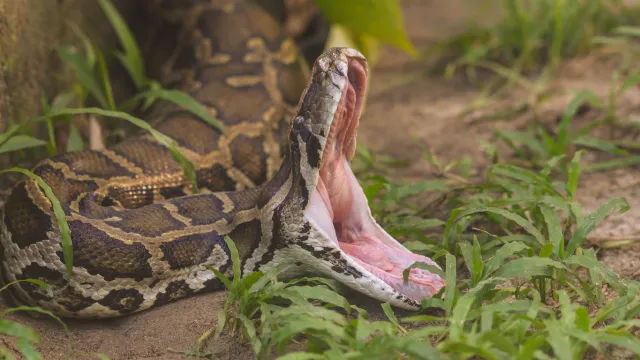Woman Finds 10-Foot Invasive Python in Her Backyard—Where It Was Hiding

It can be easy to forget that no matter how much we manicure lawns and tend to gardens, our homes are still little slices of nature. This also means that we share our outdoor space with the animals that consider it home—including reptiles. But while a snake on your property can often be a sign of a healthy local ecosystem, it’s a little different when they’re too close for comfort or get into places where they could pose a risk to humans or themselves. And in one recent instance, a woman was shocked to find a 10-foot invasive python in her backyard.
RELATED: Rattlesnake Attack Has Trauma Doctor Issuing a New Warning.
On Dec. 27, Jane Spencer says she had just stepped outside to spend the day enjoying some downtime by the pool in her Lely Resort, Florida, home, local NBC affiliate WBBH reports. But when she looked out of the screen of her porch across the backyard, she happened to notice a 10-foot-long Burmese python hiding in a pond just 20 feet away from where she was standing.
Spencer said she was initially shocked by the sight before she decided to call professionals to come and assess the situation. But when they arrived, the reptile’s hiding place made it even more difficult to wrangle and safely remove than anticipated.
“[I] couldn’t get the noose around the head,” Jesse Richards, a wildlife trapper with Sleth Reptiles, told WBBH. “He was doing this number, and then all of a sudden, he shot out into the lake,” Richards said. “So, we literally ditched the sticks, jumped on it by the tail, and had the back end like this much, and we’re both struggling, doing this under trying to fight it.”
The animal control team soon realized they would have to enter the water to successfully capture the snake—which led to them nearly getting bitten.
“We pull it out. As soon as he was free, he turned around and came right at me,” Richards told the news outlet. “At the same time, I slipped and lost my grip. So, now he’s right at my feet.”
The close encounter with the python is just the latest example of Florida’s ongoing struggle with invasive Burmese pythons. The massive reptiles have begun to spread across the state in recent decades after they were likely released into the wild by pet owners, The New York Times reported last year. Officials say the non-native predators have since done significant damage to local ecosystems as they feed on mammals, birds, and other animals—including endangered species.
While their numbers were first noted in the marshy areas in the southernmost regions of the state, the pythons have since begun to expand their territory and migrate north to places like Fort Myers and West Palm Beach, per The Times.
Now, the animal control team involved in capturing the latest 10-foot snake said removing the reptile would likely save local animal life and pets while keeping homeowners safe.
“They’re coming out of the Everglades, and they’re hungry,” Seth Spencer, the other member of the Sleth Reptile team that caught the python, told WBBH.
RELATED: For more up-to-date information, sign up for our daily newsletter.